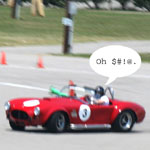 
 Main Menu
Main Menu
|
 Nevada Classics
Nevada Classics
|
 Advertise at CC
Advertise at CC
|
 November 2025
November 2025
|
| S |
M |
T |
W |
T |
F |
S |
| |
|
|
|
|
|
1 |
| 2 |
3 |
4 |
5 |
6 |
7 |
8 |
| 9 |
10 |
11 |
12 |
13 |
14 |
15 |
| 16 |
17 |
18 |
19 |
20 |
21 |
22 |
| 23 |
24 |
25 |
26 |
27 |
28 |
29 |
| 30 |
|
|
|
|
|
|
|
 CC Advertisers
CC Advertisers
|
|

08-03-2001, 06:39 AM
|
 |
(An All-Around Nice Guy)

|
|
|
Join Date: Aug 2000
Location: Camden,
SC
Cobra Make, Engine: Unique Motorcars (sold)
Posts: 1,582
|
|

 Not Ranked
Not Ranked
 Dumb Question: Vapor Lock? Percolation?
Dumb Question: Vapor Lock? Percolation?
Nearly embarassed to ask, but...
I've been following the other thread about the owner of a '34 roadster with a 392 Hemi (geeeez...) who has the carburator problems. So I just gotta clear up a question that I've had for years:
What in the heck is vapor lock, anyway? What causes it?
And what's all this talk about percolating? Isn't that what coffee does?
Keith
__________________
Keith 
Former Unique owner.
Last edited by excelguru; 08-03-2001 at 08:02 AM..
|
-
Advertising


08-03-2001, 07:43 AM
|
 |
Senior Club Cobra Member

|

|
|
Join Date: Mar 2001
Location: Northport,
NY
Cobra Make, Engine: Kirkham, KMP178 / '66 GT350H, 4-speed
Posts: 10,362
|
|

 Not Ranked
Not Ranked
 Definition...
Definition...
Vapor lock occurs in a gasoline engine when some of the gasoline boils in the fuel-supply system. Excessive heating of the engine may cause boiling, or vaporization, of the fuel. This reduces the amount of fuel pumped to the engine, because vapor takes up more space than liquid. The engine then runs erratically or stops until the vaporized gasoline cools and turns to liquid. Vapor locks occur most often during long, steep climbs on hot days, or when slowing suddenly after a hard drive.
...from http://www.discovery.com/ |

08-03-2001, 07:54 AM
|
 |
CC Member

|
|
|
Join Date: May 2000
Location: Northern VA,
VA
Cobra Make, Engine: Classic Roadsters
Posts: 2,765
|
|

 Not Ranked
Not Ranked
back in the old days you used to hear about this a lot. Now I think it mostly happens when you run the fuel line too close to the headers.
The popular sizes for the Chrysler Hemi are 392 and 426. Are you sure about what you posted, 396?
Ed
|

08-03-2001, 08:14 AM
|
 |
(An All-Around Nice Guy)

|
|
|
Join Date: Aug 2000
Location: Camden,
SC
Cobra Make, Engine: Unique Motorcars (sold)
Posts: 1,582
|
|

 Not Ranked
Not Ranked
Oops... I corrected my post to read 392...
That's an excellent explanation for vaporlock. I can understand that completely. 
Okay, so what's with the percolating thing? And what's with using the insulating spacer under the carb? Is it to keep the fuel from boiling in the bowls of the carb? (Please excuse the absurdity of the question.) Can the carbs really get that darned hot on the intake manifold? Very intersting.
And while I'm in a dumb question mood, what is a power valve? I hear people say that they "blew out" their power valve because they did something (but I don't know what).
Thanks guys,
Keith
If the carbs would just use MS Excel, I could figure all this stuff out. 
__________________
Keith 
Former Unique owner.
|

08-03-2001, 09:14 AM
|
 |
CC Member

|
|
|
Join Date: Jul 1999
Location: Prescott Valley,
AZ
Cobra Make, Engine: Previous ERA owner on break
Posts: 600
|
|

 Not Ranked
Not Ranked

To answer question #1: Yes. Gasoline, like any other liquid, has a "vapor point" where it turns from liquid to gas via evaporation. Obviously, as the temperature of the fuel rises, it turns into a gas more readily; this is exacerbated by high under-hood temperatures. Once the fuel reaches its vapor point, it will turn to gas and interrupt the proper delivery of fuel to the metering mechanisms in the carb. Keep in mind that the temperatures inside the combustion chamber may exceed 1800 deg F; exhaust gas temperatures reach 1200 deg F. This heat is transfered to your exhaust headers and subsequently to the air inside the engine compartment, heating up everything under the hood, including your fuel lines and carbs. This is why proper ventilation of the engine compartment is important. Fuel and air flow through the carb help reduce and stabilize the temperature of the fuel in the float bowls, but if the air temp is too hot, it will result in heating of the carb structure and subsequently the fuel in the float bowls. Also, if the fuel lines are routed too close to heat-producing parts, line exhaust headers, the fuel can vaporize in the line, interrupting the delivery of fuel to the float bowls.
BTW, modern gasoline is specifically formulated to raise the vapor point with the express purpose of reducing evaporative emissions from the fuel tank. This isn't a big problem with fuel injected cars, since the injectors are more efficient at atomizing the fuel (through the spraying action) than carburetors, which depend on venturis and pressure differential to atomize the fuel. Consequently, carb'ed engines tend to run less efficiently on the "new" gasolines than they did on the old blends, even after accounting for the reduction in octane rating.
As to questin #2, the purpose of the power valve, as discussed in other forums, is to provide a richer fuel/air mixture under conditions of increased power demand, such as when climbing a hill or pulling a trailer. As the throttle is depressed to maintain speed (read: engine rpm) under increased load, the throttle plates open up, reducing the manifold vacuum inside the intake manifold. The power valve senses this and opens up to admit more fuel to the metering circuit, resulting in a slightly higher fuel/air ratio. A higher fuel/air ratio will result in slightly lower combustion temps due to incomplete combustion of the mixture. (All old VW people know that to reduce combustion temps, which was vital to engine life in an air-cooled engine, you jetted the carbs richer.) To my knowledge, only the Holley and Holley-based carbs use power valves. GM Quadrajets, for example, accomplish the same function by using tapered metering rods which are pulled up through the main jets as the throttle linkage is moved, effectively varying the main jet size as a function of throttle position.
For more info on the Holley power valves, see:
http://www.holley.com/HiOctn/TechSer...o/TI-222A.html
Early Holleys had no protection in the air passage between the manifold and the valve. The valve itself has a rubber diaphragm against which the manifold vacuum acts. The valve is normally held closed by the manifold vacuum. As the manifold vacuum decreases the spring overcomes the diaphragm vacuum and causes the valve to open, admitting more fuel to the metering circuit. Since the passage to the back side of the diaphragm was open, a backfire through the intake manifold would cause the diaphragm to rupture, resulting in the valve being constantly open and an excessively rich fuel mixture throughout the normal operating range. This is what's referred to as "blowing the power valve." The only fix is to replace the valve, which requires a partial tear-down of the carb. The more recent Holleys have small ball check valves installed in the passage to prevent this. Holley also sells a kit to retrofit older carbs.
Ow, Ow, somebody's slapping me again..... 
__________________
Some folks drink from the fountain of knowledge; others just gargle.
Yesterday's flower children are today's blooming idiots.
|

08-03-2001, 11:35 AM
|
|
CC Member

|
|
|
Join Date: Feb 2001
Location: Southern,
IN
Cobra Make, Engine: SPF
Posts: 118
|
|

 Not Ranked
Not Ranked
 Percolation
Percolation
I have the Demon carb with sight glass on the bowls. After a long run in the heat of the summer, the fuel could actually be seen, through the sight glass, boiling. Caused some real drivability problems. Worst was it would simply cause the car to die in city driving (after coming off expressway) and would not restart for 15 minutes. This was becoming common on a hot fall day when the gas stations were pumping winter blend gas.
I made a large fiberglass barrier to separate the carb from the engine. Looked like a cafeteria serving tray stuck inder the carb. Worked great. Looked bad. Carb temps dropped more than 50 degrees. A lot more than 50 degrees. But it was really ugly. So I switched to an aluminum barrier for looks. Not quite a turkey pan. I piddle with the carb too much to ever put a turkey pan on. More of a "cake pan" I would say. Aluminum is a stupid thing to make a heat shield out of. It conducts heat as good as copper. It still dropped the carb temps enough to kill the percolation.
Bob

|

08-03-2001, 12:25 PM
|
|
Senior Club Cobra Member

|
|
|
Join Date: Jun 2001
Location: North Metro Atlanta,
GA
Cobra Make, Engine: 2 dr roadster, V-8, 4 spd.
Posts: 2,780
|
|

 Not Ranked
Not Ranked
Keith, I would think if you run a 4 barrel with a "turkey pan" it would shield it a good bit from heat as well. No significant vapor lock so far with mine. The above answers are excellent. The fuel injection lines on planes get it all the time after a quick gas stop since they are literally an inch away from the cylinder jugs. There are procedures to literally circulate all the fuel in the system, sending hot fuel/vapor into wing tank, and restoring lines with cold fuel for start. Watch a 6 cylinder plane (i.e. a Bonanza, Cessna 206, Saratoga) come in for a stop and see how long it takes to start!
|

08-09-2001, 08:22 PM
|
|
CC Member

|
|
|
Join Date: Mar 1999
Location: Raleigh NC USA,
Posts: 273
|
|

 Not Ranked
Not Ranked
Carb spacers made from heat resistance plastic or wood are real effective at shielding the carb from the hot manifold. I installed a 1" carb spacer on my 351C to prevent vapor lock. I also wrapped my fuel line in metallic shielding to help keep it cooler.
Once you experience vapor lock in the middle of a busy intersection you'll do anything to keep your fuel cool!!
Oh yeah, and driving five miles home with a blown power valve is no picnic either!!!! After that little experience, I always carried a spare and my wrenches.
Cheers
Jim
|

08-09-2001, 08:30 PM
|
|
Senior Club Cobra Member

|
|
|
Join Date: Jun 2001
Location: North Metro Atlanta,
GA
Cobra Make, Engine: 2 dr roadster, V-8, 4 spd.
Posts: 2,780
|
|

 Not Ranked
Not Ranked
Jim, what are the symptoms of a bad power valve? What is probability of this 1960s technology playing games?
My Cobra trunk is already full of tools and spare parts, need to know if I have to kraft space for power valve.
|

08-09-2001, 09:04 PM
|
|
CC Member

|
|
|
Join Date: Mar 1999
Location: Raleigh NC USA,
Posts: 273
|
|

 Not Ranked
Not Ranked

Bad power valves can be easily identified by the way they hang out on street corners, smoking cigerettes and wearing leather jackets. 
However, the really bad ones (in your carb) will cause your car to idle very rough, emitting large clouds of black exhaust. What's happening is that your carb is letting way too much fuel into the engine, causing it to run too rich. When you step on the gas, the engine smooths out (because it now has the right amount of fuel/air mixture) The only way to drive a car with a blown power valve is to constantly blip the throttle, otherwise the engine will stall.
Replacing a power valve involves removing the metering plate from the carb, which can be done while the carb is still on the engine but it's much easier to take the carb off. You then take a 1" open wrench and un-screw the power valve. Be sure to center up the round power valve gasket when re-installing the new valve. You will also probably need to replace your spark plugs as well since you most likely fouled them.
The first day I drove my Cobra, I fouled the plugs (due to main jets that were too large) and almost didn't make it home. Ever since, I always had a set of new plugs in the trunk of my car.
You really shouldn't have any problems with a power valve unless you have an older Holley carb. Newer carbs from Holley don't suffer (as much) from blown power valves because the carbs come with a little check valve that prevents backfires from reaching the power valve. However, power valves can still fail due to dried out seals.
Cheers
Jim

|

08-09-2001, 09:41 PM
|
|
CC Member

|
|
|
Join Date: May 1999
Location: Denton, TX,
Posts: 50
|
|

 Not Ranked
Not Ranked
Also keep in mind that fuel injection systems have two things on their side in the anti-vapor battle:
1. A pressure regulating system that uses a return line (rather than dead-heading against a regulator) that is constantly flowing fuel through the system so vapor is minimized or carried back to the tank.
2. The higher pressure itself. Same thought as the radiator cap; I believe that for each pound of pressure, the boiling temp of water is raised 3 degrees. I'm sure there is a factor for fuel, and the higher pressure (like 30 to 40 psi) also helps raise the boiling point of the fuel.
I wonder if there is a fuel system that incorporates a regulator downstream of the carb with a return line to the tank. Hmmmm
Great info on the 'power valve' issue and the heat shield ideas. I'm fearing a carb less and less...
Last edited by Leo; 08-09-2001 at 09:44 PM..
|
 Posting Rules
Posting Rules
|
You may not post new threads
You may not post replies
You may not post attachments
You may not edit your posts
HTML code is On
|
|
|
All times are GMT -7. The time now is 01:03 AM.
|




















 Linear Mode
Linear Mode



